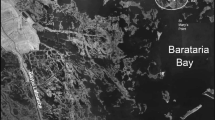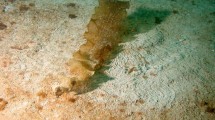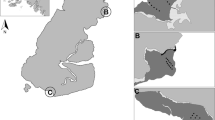Abstract
Sampling fishes in vegetated intertidal wetlands is logistically challenging. We modified the 2 × 3-m2 bottomless lift net developed for sampling nekton (fish and decapod crustaceans) on the surface of salt marshes for use in tidal mangrove forests with a woody (as opposed to herbaceous) underground root system. As originally designed (Rozas, Mar Ecol Prog Ser 89:287–292, 1992), the lift net was buried directly in the marsh substrate. The net was raised at slack high tide thereby encircling nekton within the enclosed area. A chain-line on the net bottom prevented escape under the net once deployed. However, when we used this same design in tidal mangrove forests, the extensive woody roots and occasional slumping sediments resulted in uneven trenches that could not be cleared effectively during sample recovery. We made 3 modifications to the original net design: (i) lined the peat trenches with aluminum channels of uniform width and depth; (ii) replaced the previous chain-line with Velcro closures that directly attached the net to the inner face of the outer wall of the aluminum channel; and (iii) removed the subtidal pan previously used for concentrating the enclosed nekton at low tide, and filled in those depressions with on-site peat. In the modified version, the aluminum trench became the only subtidal refuge available to nekton, and it was from here that we collected the sample after the forest drained. These modifications permitted high clearing efficiency (93–100%) of fin-clipped individuals of two common species of estuarine resident fishes, Kryptolebias marmoratus (mangrove rivulus) and Bathygobius soporator (frillfin goby). Additionally, the density estimates of grass shrimp (Palaemonetes spp.) increased 10-fold post-modification.

Similar content being viewed by others
References
Abel DC, Koenig CC, Davis WP (1987) Emersion in the mangrove forest fish Rivulus marmoratus: a unique response to hydrogen sulfide. Environ Biol Fishes 18:67–72
Browder JA, Restrepo VR, Rice JK, Robblee MB, Zein-Eldin Z (1999) Environmental influences on potential recruitment of pink shrimp, Farfantepenaeus duorarum, from Florida Bay nursery grounds. Estuaries 22:484–499
Crona BI, Rönnbäck P (2007) Community structure and temporal variability of juvenile fish assemblages in natural and replanted mangroves, Sonneratia alba Sm., of Gazi Bay, Kenya. Estuar Coast Shelf Sci 74:44–52
Ellis WL, Bell SS (2004) Conditional use of mangrove habitats by fishes: depth as a cue to avoid predators. Estuaries 27:966–976
Everglades Plan (2009) http://www.evergladesplan.org. Accessed 7 Jul 2009
Florida Coastal Everglades Long Term Ecological Research network (2009) http://fce.lternet.edu. Accessed 7 July 2009
Kneib RT (2000) Salt marsh ecoscapes and production transfers by estuarine nekton in the southeastern United States. In: Weinstein MP, Kreeger DA (eds) Concepts and controversies in tidal marsh ecology. Kluwer Academic Publishers, Boston, pp 267–291
Loftus WF, Eklund A-M (1994) Long-term dynamics of an Everglades small-fish assemblage. In: Ogden J, Davis S (eds) Everglades: the ecosystem and its restoration. St. Lucie Press, Delray Beach, FL, pp 461–483
Lorenz JJ, McIvor CC, Powell GVN, Frederick PC (1997) A drop net and removable walkway used to quantitatively sample fishes over wetland surfaces in the dwarf mangroves of the southern Everglades. Wetlands 17:346–359
McIvor CC, Ley JA, Bjork RD (1994) Changes in freshwater inflow from the Everglades to Florida Bay including effects on biota and biotic processes: a review. In: Ogden J, Davis S (eds) Everglades: the ecosystem and its restoration. St. Lucie Press, Delray Beach, FL, pp 117–146
Meager JJ, Vance DJ, Williamson I, Loneragan NR (2003) Microhabitat distribution of juvenile Penaeus merguiensis de Man and other epibenthic crustaceans within a mangrove forest in subtropical Australia. J Exp Mar Biol Ecol 294:127–144
Odum WE, McIvor CC, Smith TJ III (1982) The ecology of the mangroves of South Florida: a community profile. FWS/OBS-81/24. US Fish and Wildlife Service, Office of Biological Services, Washington, DC
Osgood DT, Yozzo DJ, Chambers RM, Jacobson D, Hoffman T, Wnek J (2003) Tidal hydrology and habitat utilization by resident nekton in Phragmites and non-Phragmites marshes. Estuaries 26:522–533
Provost MW (1974) Mean high water mark and use of tidelands in Florida. Fla Sci 36:50–66
Richards T, Krebs J, McIvor CC (in revision) Microhabitat associations of a semi-terrestrial fish, Kryptolebias marmoratus (Poey 1880) in a mosquito-ditched mangrove forest, west-central Florida. J Exp Mar Biol Ecol
Robertson AI, Duke NC (1990) Mangrove fish-communities in tropical Queensland, Australia: spatial and temporal patterns in densities, biomass, and community structure. Mar Biol 104:369–379
Rozas LP (1992) Bottomless lift net for sampling nekton on intertidal marshes. Mar Ecol Prog Ser 89:287–292
Rozas LP, Minello TJ (1997) Estimating densities of small fishes and decapod crustaceans in shallow estuarine habitats: a review of sampling design with focus on gear selection. Estuaries 20:199–213
Rozas LP, Minello TJ, Zimmerman RJ, Caldwell P (2007) Nekton populations, long-term wetland loss, and the effect of habitat restoration in Galveston Bay, Texas, USA. Mar Ecol Prog Ser 344:119–130
Taylor DS (2000) Biology and ecology of Rivulus marmoratus: new insights and a review. Fla Sci 63:242–255
Taylor DS, Snelson FF Jr (1992) Mangrove rivulus. In: Gilbert CR (ed) Rare and endangered biota of Florida: vol II. Fishes. University Press of Florida, Gainesville FL, pp 200–207
Winer BJ (1971) Statistical principles in experimental design, 2nd edn. McGraw-Hill, NY
Zar JH (1999) Biostatistical analysis, 4th edn. Prentice Hall, New Jersey
Acknowledgements
We thank D Wegener for assistance in the machine shop, and a host of people for assistance in the field; K Hart, S Whaley, K Kuss, P George, BJ Reynolds, GL Hill, N Buster, A Brame, and J Krebs. Additionally, we thank J Krebs for statistical assistance. This manuscript has been improved by suggestions from LP Rozas and two anonymous reviewers. This work was funded by the USGS, Florida Integrated Science Center through the Priority Ecosystem Science program, and by the US Army Corps of Engineers through the MAP RECOVER program for Everglades Restoration. Any use of trade names is for descriptive purposes only and does not imply endorsement by the U.S. Government.
Funding
This work was funded by the USGS, Florida Integrated Science Center through the Priority Ecosystem Science program, and by the US Army Corps of Engineers through the MAP RECOVER program for Everglades Restoration.
Author information
Authors and Affiliations
Corresponding author
Rights and permissions
About this article
Cite this article
McIvor, C.C., Silverman, N.L. Modifications to the bottomless lift net for sampling nekton in tidal mangrove forests. Wetlands Ecol Manage 18, 627–635 (2010). https://doi.org/10.1007/s11273-010-9184-0
Received:
Accepted:
Published:
Issue Date:
DOI: https://doi.org/10.1007/s11273-010-9184-0




